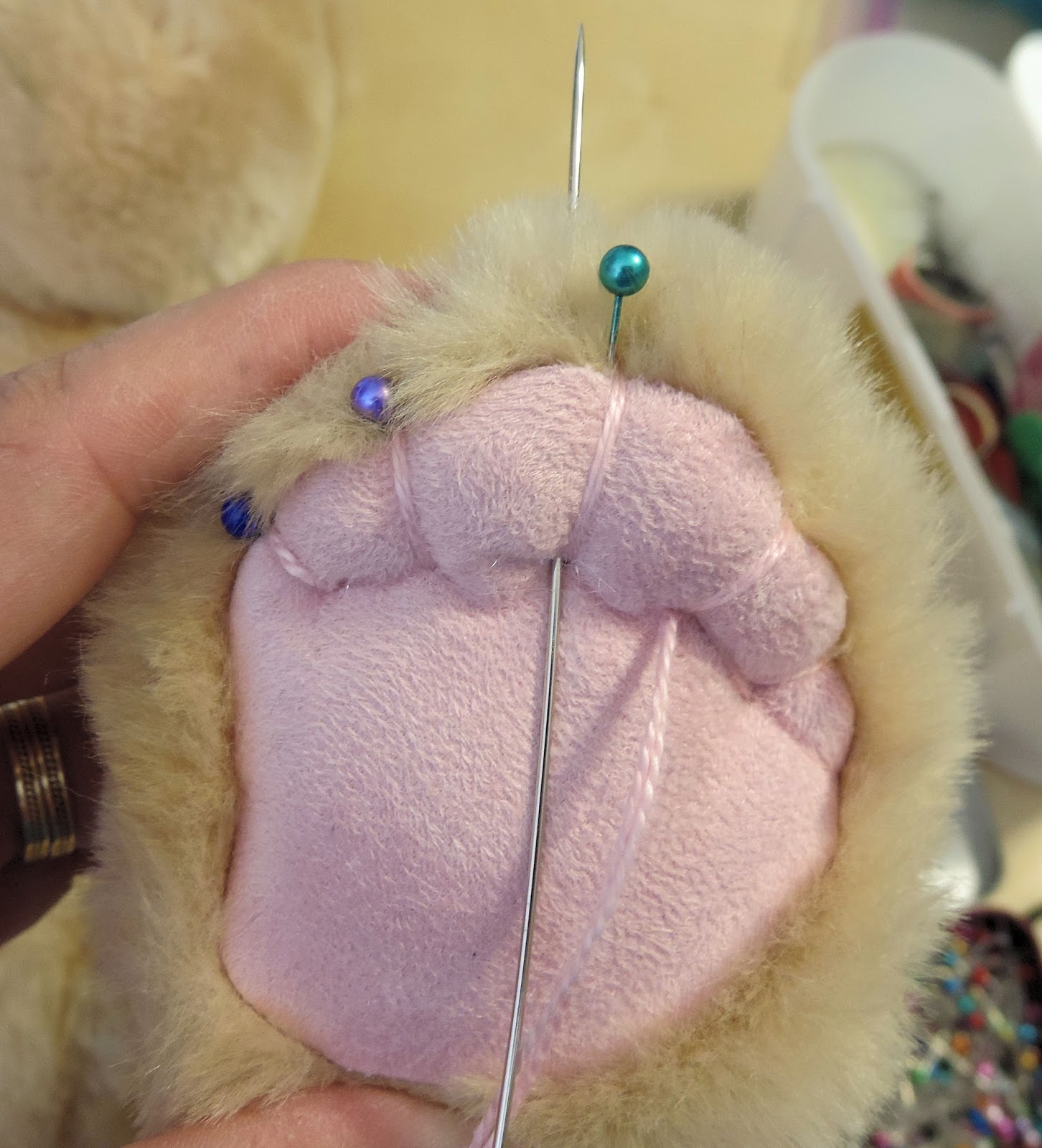Making the sculpted or puffy paws on a stuffed animal or bear:
This is a style of "toes" I love doing on any animal- dragon, dog, bear. It is time consuming and you have to work accurately but so worth it. There are several tricks to do this effectively and I am sure there are many ways to do this differently too : ) This is my way...
Here is one finished doggy pad next to an unfinished one. The paw pad is slightly shaped to be wider at the top than the bottom and this one is ultra suede. I have done this style paw pad on several animals and several different fabrics. The technique is the same for all fabrics, but stretchy fabrics work better. Felt does tend to pucker rather than make the pads smooth.
Here is how I start:
1. I have cut and sewn all parts and turned the leg right side out. I now stuff the toe area of the leg and I do this VERY LIGHTLY. You do not want a firmly stuffed toe area as this will not allow the fabric and embroidery thread to pull in to form the toes. I read somewhere that the feel of a ripe tomato is a good comparison to aim for. I am pretty sure it is Nancy Tillberg of KranBearys who said that in her book 101 Bears to Make. This is the first trick- do not overstuff. Get the stuffing even all over the paw too paying attention to the seam edges.
2. You need a long doll needle: 7 inches or so, nothing shorter than 4 inches unless you are doing a small animal then it does not matter. I use embroidery floss that matches my paw base color- here it is all pink. Use a strong thread to do this as you will be pulling hard on it and normal sewing thread will break. Upholstery thread is also a good choise. You can use a contrasting thread to add some zizzle, but remember that you have to work very accurately to do this as any imperfection will show up. I thread my needle a little differently here too.
My kit to do the paw pads
Threading the needle
Start with a long piece of thread- always longer than you think. For this puppy with a large paw my folded length was 30 inches (75 cm) - so original length was 60 inches. Fold your strong thread in half. I now thread the needle by pulling the
two cut ends though the eye and leave a tail of about 2 inches. The folded loop is all the way on the other end. This will help me start my paw pad sewing without having to tie a knot.
3. Mark your sewing points on the pad. I do this using pins with colored heads.
Paw pad ready to pin
How to evenly space the pads- use something like your finger to get the same size space each time
Pins in place to show where the thread must go
I want to end up with 4 puffy toes so I use 5 pins across the top of the paw pad. The first pin I place is the one on the center top edge of the paw. The green one in the picture. Next place 1 pin at equal distances from the center green pin, one on each side of the center pin (the pink and blue pins). Lastly place more pins - again an equal distance from the last pins (the purple pins). The gap between each pin should be the same all the way. The shape of the pad helps make the outer paws seem smaller when we sew. Now place a pin that marks how deep you want the paw to go. My yellow pin.
4. The needle is pushed through the paw from the top - use the center line of the paw as a guide and push the needle through to the gold pin that marks how deep you want to go for you pads. Pull the needle but do not pull the thread all the way through.
Needle through paw
The needle now loops over the top of the paw and you push the needle through the loop at the end of your thread. Now pull the thread tight. By going though that loop your thread is now secure and you do not need to tie a knot.
thread through the loop to secure
Pull thread tight
Pull the thread tight. On the other side of the paw you will start to see a shaping happening. Push the needle through the fabric again- go in at the center seam again in the same spot you started at but come out in the paw pad.The needle needs to be the depth down (yellow pin) but in line with one of the second pins you put in place. Wrap the thread over the top of the paw. Push the needle from the top of the paw back through to the under side of the paw in line with the outer most pin on the one side. Remember to go down to the depth of your pin. The stitches are angled slightly. You need to keep the tension on your thread that is shaping the edges of the pads as you go. The thread is wrapped straight over the top of the paw and not to the middle seam. You are moving out away from the center. (Hope that makes sense. May need more photos...)
Stitching the paw pad
The stitches are wrapped all the way over the paw and slanted slightly. I think I need more photos to show this...

























